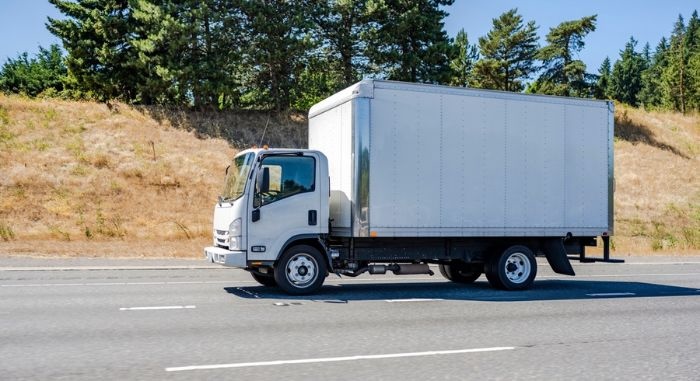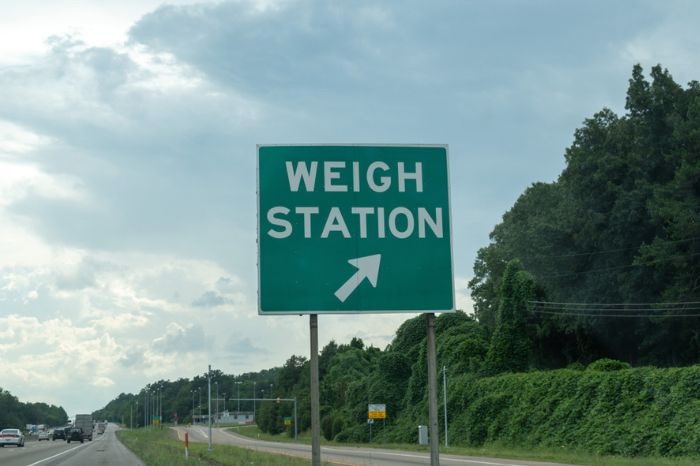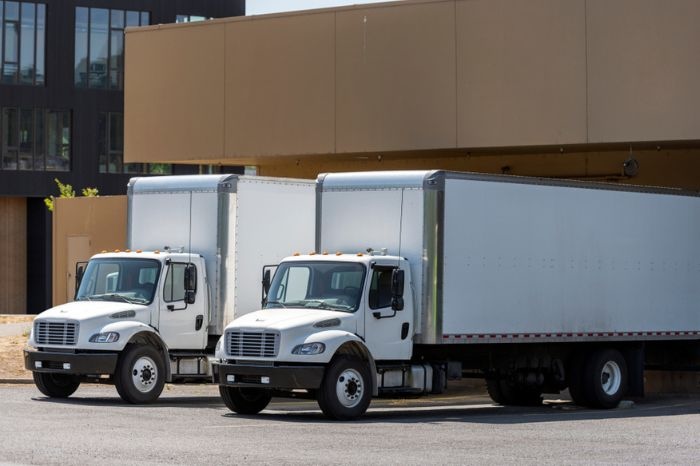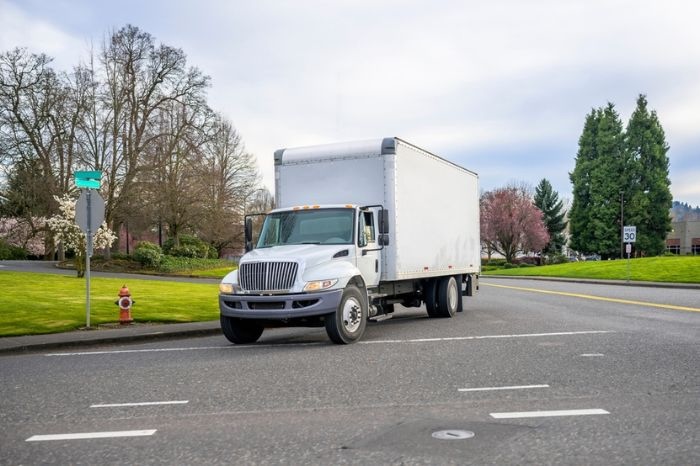
Navigating the world of box truck weight limits and regulations can feel like a daunting task, but it is essential for any driver. Weight limits aren’t just about red tape; they are vital to ensuring safety on the highways for both you and other drivers.
As you begin your box truck driving journey, understanding the weight limits becomes more than just a necessity – it’s your key to a smoother, safer drive.
We’ll dive into the details of box truck weight limits and capacity, covering everything you need to know to steer clear of trouble and keep on trucking safely and confidently. Get ready to learn more about different box truck types, sizes, and weight limits.
Understanding Box Truck Weight Limits
**Click to auto scroll by section.
- Box Truck Weight Limits and GVWR
- Box Truck Weight Classifications
- Different Types of Box Trucks, Weight Limits, and Sizes
- What is a CDL? Do I Need a CDL to Drive a Box Truck?
- State and Federal Box Truck Weight Limits & Regulations
- Make Money With LoadUp! Opportunities for Independent Box Truck Drivers
- Navigating Box Truck Weight Limits
Box Truck Weight Limits and GVWR
Knowing how much weight your box truck can safely carry is an important part of truck driving. Every box truck has a limit that is known as the GVWR, or Gross Vehicle Weight Rating. The GVWR tells you the maximum weight capacity that your box truck can safely handle.
For example, let’s say you have a box truck with a GVWR of 14,000 pounds. This means the total weight of the straight truck, including its own weight and whatever it’s carrying, can’t be more than 14,000 pounds.
Imagine the truck itself weighs 8,000 pounds when it’s empty. This means you can load it with up to 6,000 pounds of cargo. If you load more than that, you’ll be over the 14,000-pound limit.

Overloading your truck can be dangerous. When a truck carries too much weight, parts like brakes, tires, and suspension can get worn out much faster and function poorly. They might even break down, which can be really dangerous.
Also, an overloaded truck is harder to control. It can make your truck take longer to stop and be tough to steer. This makes driving a lot more dangerous for you and everyone else on the road.
Always check your box truck’s GVWR and make sure you don’t go over the limit. It’s not just about following rules – it’s about keeping you and other drivers safe.
Trucker Tip: Your box trucks Gross Vehicle Weight Rating and max payload will be displayed on the inside of the drivers door jamb along with the Gross Axle Weight Rating and more information.
Box Truck Weight Classifications
Trucks are classified by their GVWR. There are 8 different truck classification categories as defined by the DOT, going all the way up to 80,000 GVWR for tractor-trailers.
In simpler terms, trucks can be classified as light-duty, medium-duty, and heavy-duty. Most box trucks fall in the light-duty and medium-duty categories.
Light-Duty
Light-duty box trucks are classified as having a GVWR up to 14,000 lbs. Light-duty trucks are commonly used for moving jobs, light commercial jobs like deliveries, and small-scale hauling. They’re ideal for use in urban areas due to their manageable size and efficiency.
Medium-Duty
Medium-duty box trucks are classified as having a GVWR of 14,001 – 26,000 lbs. Medium-duty trucks are often used for larger commercial activities like transporting goods, moving jobs, and specialized services such as junk removal or utility work, offering a balance of size and hauling capacity.
Heavy-Duty
Heavy-duty trucks are any truck with a GVWR over 26,000 lbs. When referring to heavy-duty trucks, they are primarily semi-trucks or tractor-trailers. Certain box trucks are considered heavy-duty, but for the most part, box trucks fit into the light and medium-duty category.

Different Types of Box Trucks, Weight Limits, and Sizes
Box truck weight limits and sizes can vary. Common box truck sizes have GVWRs ranging from 8000 to 33,000 pounds. However, the exact payload capacity depends on your straight truck’s make and model.
Always check your specific box truck’s GVWR and maximum payload capacity before loading to ensure safety and legality.
How much weight can a box truck carry?
| Truck Size | GVWR | Max Payload | CDL Required? |
| 10′ Truck | 8600 lbs | 2850 lbs | No |
| 12′ Truck | 9900 lbs | 3100 lbs | No |
| 16′ Truck | 12,500 lbs | 4300 lbs | No |
| 24′ Truck | 26,000 lbs | 10,000 lbs | No |
| 26′ Truck | 26,000 lbs | 12,000 lbs | No |
| 26′ Truck | 33,000 lbs | 17,000 lbs | Yes |
While federal laws set general Commercial Driver’s License requirements, it’s important to note that minimum CDL laws can differ from state to state.
The CDL requirements shown above apply primarily to personal use of box trucks. However, if you’re driving a box truck for commercial purposes, the need for a CDL could change.
It’s important to check both federal and your specific state’s regulations to understand the exact CDL requirements for commercial box truck driving in your area.
What is a CDL? Do I Need a CDL to Drive a Box Truck?
Most box trucks do not require a CDL to be driven. A Commercial Driver’s License (CDL) is a special license required in the United States for drivers operating certain types of vehicles. The need for a CDL depends on the vehicle’s type and its intended use. There are three main classes of CDLs: Class A, B, and C.
- Class A CDL – Required for any combination of vehicles with a GVWR of 26,001 lbs or more, with the towed vehicle weighting at least 10,000 pounds.
- Class B CDL – Required for drivers operating a single vehicle with a GVWR of 26,001 pounds or more, or towing a trailer less than 10,000 pounds.
- Class C CDL – Required for drivers operating vehicles designed to transport 16 or more passengers (including the driver) or hazardous materials.
For most box trucks, a CDL isn’t required as long as the straight truck’s GVWR is under 26,000 pounds. This means if you’re driving a smaller box truck for personal use that falls below this weight limit, you typically won’t need a CDL.

However, it’s important to check the specific requirements for your vehicle and its usage, as other factors might necessitate a CDL. Always ensure you’re fully compliant with licensing regulations to avoid legal issues.
Even if a CDL isn’t required, learning to safely drive a box truck is important, especially for first-timers. Familiarizing yourself with your box trucks weight limit, handling, size, and blind spots helps ensure safety for you and others on the road.
Safety First! If you aren’t familiar with driving a larger sized box truck, it is best to take a straight truck driving course to prepare. If this is not available, practice driving around an empty lot first.
State and Federal Box Truck Weight Limits & Regulations
Keeping up with state and federal regulations for box truck driving can be complex, as these rules often differ. While federal regulations provide a baseline for box truck driving and use, state laws can vary significantly, affecting everything from box truck weight limits to driver licensing requirements.
Tips on Staying Compliant
- Stay Informed: Regularly check both state and federal transportation websites for updates. Changes in regulations can happen, and staying informed is key to driving legally.
- Understand Your Route: If you’re crossing state lines, be aware of the regulations in each state you’ll be traveling through. What’s permissible in one state might not be in another.
- Seek Local Guidance: Consider joining local trucking associations or groups where members often share insights and updates on regulatory changes.
Exceptions to DOT Regulations
- Agricultural Use: Some states have different requirements for vehicles used exclusively for agricultural purposes within certain areas.
- Emergency Vehicles: Emergency and certain service vehicles are usually exempt from standard weight and licensing regulations.
- Urban vs. Rural Operations: Some areas might have specific rules for urban or rural operations, affecting routes and vehicle sizes.
Being aware of these laws and staying up to date on regulatory changes is important for any box truck driver, ensuring both legal compliance and safe driving.

Make Money With LoadUp! Opportunities for Independent Box Truck Drivers
If you own a box truck, you can use it to earn money as an independent contractor with us at LoadUp. We offer nationwide junk removal services for both residential and commercial customers.
Sign up with LoadUp and you’ll gain access to a variety of local junk removal jobs. Our platform offers the flexibility to truly be your own boss. You have the freedom to choose your working hours, selecting only the jobs that suit you best.
Whether you’re looking to do this full-time or just as a side gig for some extra income, LoadUp provides a lucrative option to make the most out of your box truck. It’s an excellent way to monetize your vehicle while enjoying the perks of independent, flexible work.
Want To Become A LoadUp Partner? SIGN UP
Understanding and adhering to box truck weight limits, CDL requirements, and state and federal restrictions is essential for safe and legal operation of your box truck.
While it may seem confusing at first, staying informed and compliant ensures not only your safety but also the safety of others on the road.

Additionally, owning a box truck opens up lucrative opportunities, like becoming an independent contractor with companies like LoadUp, allowing you to be your own boss and work on your terms.
Whether you’re driving for personal reasons or as a job, knowledge and compliance are key. Remember, a well-maintained truck and an informed driver are the backbone of safe and successful box truck operations.
Related Articles from the Trash Talk Blog:

